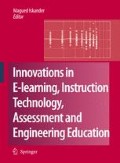Abstract
Students planning to work in the software industry are best served by exposure to the type of skills necessary to acquire employment in a software developer capacity. One way to prepare students is to teach students the software development life-cycle process utilizing a design and implementation two-course capstone project. This paper describes a successful teaching approach to the capstone project by utilizing a practical hands-on approach.
Access this chapter
Tax calculation will be finalised at checkout
Purchases are for personal use only
Preview
Unable to display preview. Download preview PDF.
References
Amento, B., Terveen, L., and Hill, W. Does Authority Mean Quality? Predicting Expert Ratings of Web Documents. AT&T Shannon Laboratories (2000).
Bailey, J., and Stefaniak, G. Preparing the Information Technology Workforce for the New Millennium. Proceedings of the SIGCPRS (2000), 1-7.
Becker-Kornstaedt, U. Towards Systematic Knowledge Elicitation for Descriptive Software Process Modeling. Proceedings of the PROFES (2001), 1-18.
Computer Science and Telecommunications Board, National Research Council. Building a Workforce for the Information Economy. National Academy Press, Washington DC, 2001.
Ecker, P., Caudill, J., Hoctor, D., and Meyer, C. Implementing an Interdisciplinary Capstone Course for Associate Degree Information Technology Programs. Proceedings of the SIGITE’04 (2004), 60-65.
Friedman, R., McHugh, J., and Deek, F. NJIT’s Sandbox: An Industry/Education Partnership for IT Development. Proceedings of the CITC4’03 (2003), 201-205.
Gause, D., and Weinberg, G . Exploring Requirements: Quality Before Design. Dorset House Publishing, New York, NY, 1989.
Green, L. Projecting IT Education into the Real World. Proceedings of the CITC4’03 (2003), 111-114.
Mann, J. IT Education’s Failure to Deliver Successful Information Systems: Now is the Time to Address the IT-User Gap. Journal of Information Technology Education, 1, (2002), 253-267.
Peterson, M., Morneau, K., and Saad, A. Preparing the New Information Technology Professional in Virginia. Proceedings of the CITC4 (2003), 28-30.
Author information
Authors and Affiliations
Editor information
Editors and Affiliations
Rights and permissions
Copyright information
© 2007 Springer
About this paper
Cite this paper
Catanio, J.T. (2007). A Hands-on Approach to Capstone Design and Implementation. In: Iskander, M. (eds) Innovations in E-learning, Instruction Technology, Assessment, and Engineering Education. Springer, Dordrecht. https://doi.org/10.1007/978-1-4020-6262-9_33
Download citation
DOI: https://doi.org/10.1007/978-1-4020-6262-9_33
Publisher Name: Springer, Dordrecht
Print ISBN: 978-1-4020-6261-2
Online ISBN: 978-1-4020-6262-9
eBook Packages: EngineeringEngineering (R0)

